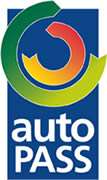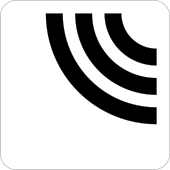Autopass
Autopass (stylized autoPASS) is an electronic toll collection system used in Norway. It allows collecting road tolls automatically from cars. It uses electronic radio transmitters and receivers operating at 5.8 GHz (MD5885) originally supplied by the Norwegian companies Q-Free and Fenrits. Since 2013 Kapsch and Norbit supplied the transponders.[3] In 2016 the Norwegian Public Roads Administration revealed that they had chosen Norbit and Q-Free as suppliers of Autopass-transponders the next four years.[4]



With an AutoPASS contract it is also possible to use the tag in Denmark and Sweden on ferries and bridges through the EasyGo partnership.[5][6]
In 2019 more and more ferry crossings are also using Autopass as a payment option through the "AutoPass for ferry" concept.[7] A few crossings are automatic, but most are still manual. If you have a tag you pay only for the vehicle at fully automatic crossings with a 10% discount. If you apply for an Autopass ferry account, which is prepaid, you get a 50%(40% corporate) discount for vehicle, and 17% for passengers at manual payment crossings. See https://www.autopassferje.no for more information.
Technology

The system involves the installation of a DSRC based radio transponder on the windscreen of a vehicle, and to sign an agreement with one of the toll collection companies in Norway. Tolls are charged at toll plazas and cars can drive past in over 100 kilometres per hour (62 mph). The system is administrated by the Norwegian Public Roads Administration. All public toll roads but one in Norway use the system, in addition to tests for use of the system on some car ferries. The primary reason that some projects don't support Autopass is that they charge both for the car and for passengers, which the system cannot support. All projects using Autopass can only charge per car. The only manual toll road left is the Atlantic Ocean Tunnel.
Each Autopass unit contains a microcontroller which will process requests from the road side, and respond with the proper information to the road side.
There are 5 generations of cryptographic key pairs inside each Autopass unit, which are unique for each unit. The cryptographic keys are used for authenticating the unit when passing a toll plaza, thus making it difficult to make fraudulent copies of an Autopass unit. Unlike similar DSRC based tolling systems used in many countries, there is no access control in the Norwegian system, the unique ID within the unit being available for those who have the proper DSRC equipment.
There is an internal storage space for 100 log entries, which are normally updated each time a vehicle owner is charged when passing a toll plaza. This is a collection of receipt entries which includes the time, date, and the station identity of the toll plaza which did the tolling transaction.
Each Autopass unit features a move detect mechanism. When the unit is removed from the windscreen, an electrical switch will be activated, causing a flag to be set in a processor within the Autopass unit. This flag will be registered when doing a tolling transaction the next time the unit passes a toll plaza.
Obligatory tag for heavy vehicles
As of 1 January 2015 it is compulsory for all vehicles over 3.5 tonnes (3.4 long tons; 3.9 short tons) which are registered to an enterprise, state, county, or municipal administration, or which are otherwise primarily used for business purposes, to have an electronic toll payment tag when driving in Norway. The provision has its legal basis in regulations that were adopted on 10 October 2014. It applies to all above-mentioned Norwegian and foreign vehicles on the entire public road network. Failure to carry a toll payment tag will result in a fine of 8,000 NOK. Failure to pay within three weeks means that the penalty charge will be increased to 12,000 NOK. If you are stopped twice without a tag within a period of two years, you will be fined 16,000 NOK.[8]
Supporting toll plazas
- Toll rings
- Oslo and Akershus
- Kristiansand
- Nord-Jæren
- Haugalandet
- Bergen
- Askøy
- Namsos
- Bodø
- Harstad
- Grenland
- Førde
- Trondheim
- Public roads
- E6 Helgeland nord
- E6 Helgeland sør
- E6 Trondheim–Stjørdal
- E6 Tingberg
- E6

- E6 Moss
- E6 Raukerud, Østfoldpakka
- E6 Gardermoen-Moelv, Akershus
- E6 Frya-Sjoa, Oppland
- E6

- E6/E10 Trældal - Leirvik, Nordland
- E16 Bolstad, Hordaland
- E16 Kongsvinger-Slomarka, Hedmark
- E16 Fønhus-Bagn, Oppland
- E18 Østfoldpakka, Østfold
- E18 Vestfold (Gulli-Sky)
- E39 Handeland, Vest-Agder
- E134

- E136


- Rv4 Lunner grense, Oppland
- Rv 7 Sokna-Ørgenvika, Buskerud
- Rv13

- Rv13 Svelgane, Hordaland
- Rv36 Ullevik, Telemark
- Rv 80 Nordland
- Fv7 Kvammapakken, Hordaland
- Fv16 Lunner grense, Oppland
- Fv 17 Tverlandet - Godøystraumen, Nordland
- Fv 33 Langsletta, Oppland
- Fv 34 Grime, Oppland
- Fv43 Kollevoll
- Fv45 Gjesdal, Rogaland
- Fv47

- Fv78 Vegpakke Helgeland, Nordland
- Fv107

- Fv108

- Fv118

- Fv128 Østfoldpakka
- Fv163 Around Tresfjorden, Møre og Romsdal
- Fv175 Kongsvinger-Slomarka, Hedmark
- Fv250 Kongsvinger-Slomarka, Hedmark
- Fv255 Gausdalsvegen, Oppland
- Fv311 Kambo, Østfoldpakka, Østfold
- Fv312 Frya-Sjoa
- Fv312 Skarsmoen, Oppland
- Fv315 Lundgård, Gausdalsvegen, Oppland
- Fv465 Gjervollstad, Vest-Agder
- Fv519

- Fv542 Bømlopakken, Hordaland
- Fv544 Halsnøysambandet, Hordaland
- Fv714 Laksevegen
- Fv 715 Krinsvatn
- Fv858

- Former
- Tønsberg Toll Ring
- E6 Grillstad–Værnes
- E6 Trondheim – Stjørdal
- E16 Hadelandsvegen
- E18 Buskerud
- E18 Vestfold Nord
- E18 Agder
- E39 Rennesøy Fixed Link
- E39 Triangle Link
- E39 Øysand–Thamshavn
- E134

- Rv4 Oppland
- Rv 9 Setesdal
- Rv19 Skoppum, Horten, Vestfold
- Rv55

- Fv71

- Fv108

- Fv551

- Fv562

- Fv566

- Fv661

See also
- Toll roads in Norway
- Dedicated Short Range Communications
External links
References
- "Ny mal for skilting i automatiske bomstasjoner (AB)". Vegdirektoratet. 2019.
- "Ny mal for skilting i automatiske bomstasjoner (AB)". Vegdirektoratet. 2019.
- "Her er den nye bompengebrikken". Tu.no (in Norwegian Bokmål). Retrieved 2018-01-16.
- Lynum, Sissel (2016-10-21). "Millionkontrakt til trøndersk elektronikkbedrift". adressa.no (in Norwegian Bokmål). Retrieved 2018-01-30.
- Enonic. "About AutoPASS - AutoPASS". www.autopass.no. Retrieved 2018-01-30.
- "About EasyGo | EasyGo". easygo.com. Retrieved 2018-01-30.
- "Ferjer - AutoPASS". www.autopass.no. Retrieved 6 January 2019.
- Obligatory tag for heavy vehicles Archived January 8, 2015, at the Wayback Machine